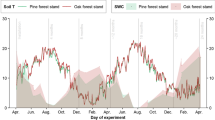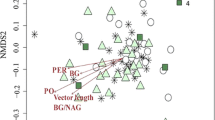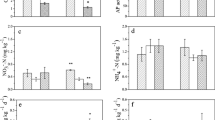Abstract
Investigations on how tree species modify decomposition of understory litter have rarely been conducted, although potentially having impacts on soil carbon stocks and stability. The aim of our study was to disentangle the effects different tree species (alder, spruce, oak, and willow) exert on litter decomposition by comparing decomposition patterns and microbial measures (phospholipid fatty acids and microbial DNA) of both tree and understory (Calamagrostis epigejos) litter exposed at the respective tree species stands of a common garden experiment. An initially uniform mass loss of understory litter exposed at the stands suggests that inherent litter quality (assessed by C:N ratios and lignin content) was the major driver in early decomposition. However, in later stages of our experiment, decomposition of understory litter began to differ among the stands, suggesting a delayed tree species effect. Here, differences in microbial community composition caused by tree species identity (e.g., through varying N supply or phenolics leached from low-quality litter) were likely the major determinants affecting the decomposition of understory litter. However, in these advanced decomposition stages, tree species identity only partly altered microbial communities associated with understory litter. These results indicate that the development of microbial communities on understory litter (and its decay) is likely a combined result of inherent chemical composition and tree species identity.





Similar content being viewed by others
References
Almendros G, Dorado J, González-Vila FJ, Blanco MJ, Lankes U (2000) 13C NMR assessment of decomposition patterns during composting of forest and shrub biomass. Soil Biol Biochem 32:793–804. https://doi.org/10.1016/S0038-0717(99)00202-3
Angst G, Heinrich L, Kögel-Knabner I, Mueller CW (2016) The fate of cutin and suberin of decaying leaves, needles and roots—inferences from the initial decomposition of bound fatty acids. Org Geochem 95:81–92. https://doi.org/10.1016/j.orggeochem.2016.02.006
Angst Š, Cajthaml T, Angst G, Šimáčková H, Brus J, Frouz J (2017) Retention of dead standing plant biomass (marcescence) increases subsequent litter decomposition in the soil organic layer. Plant Soil 418:571–579. https://doi.org/10.1007/s11104-017-3318-6
Angst G, Messinger J, Greiner M, Häusler W, Hertel D, Kirfel K, Kögel-Knabner I, Leuschner C, Rethemeyer J, Mueller CW (2018) Soil organic carbon stocks in topsoil and subsoil controlled by parent material, carbon input in the rhizosphere, and microbial-derived compounds. Soil Biol Biochem 122:19–30. https://doi.org/10.1016/J.SOILBIO.2018.03.026
Angst G, Mueller KE, Eissenstat DM, Trumbore S, Freeman KH, Hobbie SE, Chorover J, Oleksyn J, Reich PB, Mueller CW (2019) Soil organic carbon stability in forests: distinct effects of tree species identity and traits. Glob Chang Biol 25:1529–1546. https://doi.org/10.1111/gcb.14548
Artz RRE, Chapman SJ, Jean Robertson AH, Potts JM, Laggoun-Défarge F, Gogo S, Comont L, Disnar JR, Francez AJ (2008) FTIR spectroscopy can be used as a screening tool for organic matter quality in regenerating cutover peatlands. Soil Biol Biochem 40:515–527. https://doi.org/10.1016/j.soilbio.2007.09.019
Baldock JA, Oades JM, Nelson PN, Skene TM, Golchin A, Clarke P (1997) Assessing the extent of decomposition of natural organic materials using solid-state 13C NMR spectroscopy. Aust J Soil Res 35:1061–1083. https://doi.org/10.1071/s97004
Baldrian P, Trögl J, Frouz J, Šnajdr J, Valášková V, Merhautová V, Cajthaml T, Herinková J (2008) Enzyme activities and microbial biomass in topsoil layer during spontaneous succession in spoil heaps after brown coal mining. Soil Biol Biochem 40:2107–2115. https://doi.org/10.1016/j.soilbio.2008.02.019
Bauhus J, Paré D, Côté L (1998) Effects of tree species, stand age and soil type on soil microbial biomass and its activity in a southern boreal forest. Soil Biol Biochem 30:1077–1089. https://doi.org/10.1016/S0038-0717(97)00213-7
Berg B (2000) Litter decomposition and organic matter turnover in northern forest soils. For Ecol Manag 133:13–22
Berg B, McClaugherty C (2008) Plant litter decomposition, humus formation,carbon sequestration. Springer, Berlin Heidelberg
Caporaso JG, Lauber CL, Walters WA, Berg-Lyons D, Huntley J, Fierer N, Owens SM, Betley J, Fraser L, Bauer M, Gormley N, Gilbert JA, Smith G, Knight R (2012) Ultra-high-throughput microbial community analysis on the Illumina HiSeq and MiSeq platforms. ISME J 6:1621–1624. https://doi.org/10.1038/ismej.2012.8
Carreiro MM, Sinsabaugh RL, Repert DA, Parkhurst DF (2000) Microbial enzyme shifts explain litter decay responses to simulated nitrogen deposition. Ecology 81:2359–2365. https://doi.org/10.1890/0012-9658(2000)081[2359:MESELD]2.0.CO;2
Cepáková Š, Frouz J (2015) Changes in chemical composition of litter during decomposition: a review of published 13C NMR spectra. J Soil Sci Plant Nutr 15:805–815
Cepáková Š, Tošner Z, Frouz J (2016) The effect of tree species on seasonal fluctuations in water-soluble and hot water-extractable organic matter at post-mining sites. Geoderma 275:19–27. https://doi.org/10.1016/j.geoderma.2016.04.006
Chodak M, Niklińska M (2010) The effect of different tree species on the chemical and microbial properties of reclaimed mine soils. Biol Fertil Soils 46:555–566. https://doi.org/10.1007/s00374-010-0462-z
Chomel M, Guittonny-Larchevêque M, DesRochers A, Baldy V (2016) Effect of mixing herbaceous litter with tree litters on decomposition and N release in boreal plantations. Plant Soil 398:229–241. https://doi.org/10.1007/s11104-015-2648-5
Cotrufo MF, Del Galdo I, Piermatteo D (2009) Litter decomposition: concepts, methods, and future perspectives. Soil Carbon Dyn:76–91. https://doi.org/10.1017/CBO9780511711794.006
Dawson LA, Hillier S (2010) Measurement of soil characteristics for forensic applications. Surf Interface Anal 42:363–377. https://doi.org/10.1002/sia.3315
de Cárcer DA, Denman SE, McSweeney C, Morrison M (2011) Evaluation of subsampling-based normalization strategies for tagged high-throughput sequencing data sets from gut microbiomes. Appl Environ Microbiol 77:8795–8798. https://doi.org/10.1128/AEM.05491-11
Don A, Kalbitz K (2005) Amounts and degradability of dissolved organic carbon from foliar litter at different decomposition stages. Soil Biol Biochem 37:2171–2179. https://doi.org/10.1016/j.soilbio.2005.03.019
Frouz J, Elhottová D, Kuráž V, Šourková M (2006) Effects of soil macrofauna on other soil biota and soil formation in reclaimed and unreclaimed post mining sites: results of a field microcosm experiment. Appl Soil Ecol 33:308–320. https://doi.org/10.1016/j.apsoil.2005.11.001
Frouz J, Prach K, Pižl V, Háněl L, Starý J, Tajovský K, Materna J, Balík V, Kalčík J, Řehounková K (2008) Interactions between soil development, vegetation and soil fauna during spontaneous succession in post mining sites. Eur J Soil Biol 44:109–121. https://doi.org/10.1016/j.ejsobi.2007.09.002
Frouz J, Cajthaml T, Mudrák O (2011) The effect of lignin photodegradation on decomposability of Calamagrostis epigeios grass litter. Biodegradation 22:1247–1254. https://doi.org/10.1007/s10532-011-9479-8
Frouz J, Livečková M, Albrechtová J, Chroňáková A, Cajthaml T, Pižl V, Háněl L, Starý J, Baldrian P, Lhotáková Z, Šimáčková H, Cepáková Š (2013) Is the effect of trees on soil properties mediated by soil fauna? A case study from post-mining sites. For Ecol Manag 309:87–95. https://doi.org/10.1016/j.foreco.2013.02.013
Frouz J, Špaldoňová A, Lhotáková Z, Cajthaml T (2015) Major mechanisms contributing to the macrofauna-mediated slow down of litter decomposition. Soil Biol Biochem 91:23–31. https://doi.org/10.1016/j.soilbio.2015.08.024
Gartner TB, Cardon ZG (2004) Decomposition dynamics in mixed-species leaf litter. Oikos 104:230–246. https://doi.org/10.1111/j.0030-1299.2004.12738.x
Hatakka A (1994) Lignin-modifying enzymes from selected white-rot fungi: production and role in lignin degradation. FEMS Microbiol Rev 13:125–135
Hättenschwiler S (2005) Effects of tree species diversity on litter quality and decomposition. In: Scherer-Lorenzen M, Körner C, Schulze ED (eds) Forest diversity and function. Ecological Studies (Analysis and Synthesis), vol 176. Springer, Berlin, Heidelberg
Hättenschwiler S, Vitousek PM (2000) The role of polyphenols in terrestrial ecoystems nutrient cycling. Tree 15:238–243
Hobbie SE, Reich PB, Oleksyn J, Ogdahl M, Zytkowiak R, Hale C, Karolewski P (2006) Tree species effects on decomposition and forest floor dynamics in a common garden. Ecology 87:2288–2297
Hobbie SE, Ogdahl M, Chorover J, Chadwick OA, Oleksyn J, Zytkowiak R, Reich PB (2007) Tree species effects on soil organic matter dynamics: the role of soil cation composition. Ecosystems 10:999–1018. https://doi.org/10.1007/s10021-007-9073-4
Hoorens B, Aerts R, Stroetenga M (2003) Does initial litter chemistry explain litter mixture effects on decomposition? Oecologia 137:578–586. https://doi.org/10.1007/s00442-003-1365-6
Ihrmark K, Bödeker ITM, Cruz-Martinez K, Friberg H, Kubartova A, Schenck J, Strid Y, Stenlid J, Brandström-Durling M, Clemmensen KE, Lindahl BD (2012) New primers to amplify the fungal ITS2 region—evaluation by 454-sequencing of artificial and natural communities. FEMS Microbiol Ecol 82:666–677. https://doi.org/10.1111/j.1574-6941.2012.01437.x
Kiikkilä O, Kitunen V, Smolander A (2011) Properties of dissolved organic matter derived from silver birch and Norway spruce stands: degradability combined with chemical characteristics. Soil Biol Biochem 43:421–430. https://doi.org/10.1016/J.SOILBIO.2010.11.011
Laganière J, Paré D, Bradley RL (2010) How does a tree species influence litter decomposition? Separating the relative contribution of litter quality, litter mixing, and forest floor conditions. Can J For Res 40:465–475. https://doi.org/10.1139/X09-208
López-Mondéjar R, Voříšková J, Větrovský T, Baldrian P (2015) The bacterial community inhabiting temperate deciduous forests is vertically stratified and undergoes seasonal dynamics. Soil Biol Biochem 87:43–50. https://doi.org/10.1016/j.soilbio.2015.04.008
Lorenz K, Preston CM, Raspe S, Morrison IK, Feger KH (2000) Litter decomposition and humus characteristics in Canadian and German spruce ecosystems: information from tannin analysis and 13C CPMAS NMR. Soil Biol Biochem 32:779–792. https://doi.org/10.1016/S0038-0717(99)00201-1
Lorenz K, Preston CM, Krumrei S, Feger KH (2004) Decomposition of needle/leaf litter from Scots pine, black cherry, common oak and European beech at a conurbation forest site. Eur J For Res 123:177–188. https://doi.org/10.1007/s10342-004-0025-7
Marschner B, Brodowski S, Dreves A, Gleixner G, Gude A, Grootes PM, Hamer U, Heim A, Jandl G, Ji R, Kaiser K, Kalbitz K, Kramer C, Leinweber P, Rethemeyer J, Schäffer A, Schmidt MWI, Schwark L, Wiesenberg GLB (2008) How relevant is recalcitrance for the stabilization of organic matter in soils? J Plant Nutr Soil Sci 171:91–110. https://doi.org/10.1002/jpln.200700049
McClaugherty CA, Pastor J, Aber JD, Melillo JM (1985) Forest litter decomposition in relation to soil nitrogen dynamics and litter quality. Ecology 66:266–275. https://doi.org/10.2307/1941327
Melillo JM, Aber JD, Muratore JF (1982) Nitrogen and lignin control of hardwood leaf litter decomposition dynamics. Ecology 63:621–626. https://doi.org/10.2307/1936780
Meyer F, Paarmann D, D’Souza M, Olson R, Glass EM, Kubal M, Paczian T, Rodriguez A, Stevens R, Wilke A, Wilkening J, Edwards RA (2008) The metagenomics RAST server—a public resource for the automatic phylogenetic and functional analysis of metagenomes. BMC Bioinformatics 9:386. https://doi.org/10.1186/1471-2105-9-386
Mudrák O, Frouz J, Velichová V (2010) Understory vegetation in reclaimed and unreclaimed post-mining forest stands. Ecol Eng 36:783–790. https://doi.org/10.1016/j.ecoleng.2010.02.003
Osono T (2007) Ecology of ligninolytic fungi associated with leaf litter decomposition. Ecol Res 22:955–974. https://doi.org/10.1007/s11284-007-0390-z
Prach K, Pyšek P, Bastl M (2001) Spontaneous vegetation succession in human-disturbed habitats: a pattern across seres. Appl Veg Sci 4:83–88. https://doi.org/10.1111/j.1654-109X.2001.tb00237.x
Prescott CE (2010) Litter decomposition: what controls it and how can we alter it to sequester more carbon in forest soils? Biogeochemistry 101:133–149. https://doi.org/10.1007/s10533-010-9439-0
Qiao Y, Miao S, Silva LCR, Horwath WR (2014) Understory species regulate litter decomposition and accumulation of C and N in forest soils: a long-term dual-isotope experiment. For Ecol Manag 329:318–327. https://doi.org/10.1016/j.foreco.2014.04.025
R Core Team (2016). R: A language and environment for statistical computing. R foundation for statistical computing, Vienna, Austria, http://www.R-project.org/
Rebele F, Lehmann C (2001) Biological flora of Central Europe: Calamagrostis epigejos (L.) Roth. Flora 196:325–344. https://doi.org/10.1016/S0367-2530(17)30069-5
Reich PB, Oleksyn J, Modrzynski J, Mrozinski P, Hobbie SE, Eissenstat DM, Chorover J, Chadwick OA, Hale CM, Tjoelker MG (2005) Linking litter calcium, earthworms and soil properties: a common garden test with 14 tree species. Ecol Lett 8:811–818. https://doi.org/10.1111/j.1461-0248.2005.00779.x
Sagova-Mareckova M, Cermak L, Novotna J, Plhackova K, Forstova J, Kopecky J (2008) Innovative methods for soil DNA purification tested in soils with widely differing characteristics. Appl Environ Microbiol 74:2902–2907. https://doi.org/10.1128/AEM.02161-07
Sampedro I, Cajthaml T, Marinari S, Petruccioli M, Grego S, D’Annibale A (2009) Organic matter transformation and detoxification in dry olive mill residue by the saprophytic fungus Paecilomyces farinosus. Process Biochem 44:216–225. https://doi.org/10.1016/j.procbio.2008.10.016
Schöler A, Jacquiod S, Vestergaard G, Schulz S, Schloter M (2017) Analysis of soil microbial communities based on amplicon sequencing of marker genes. Biol Fertil Soils 53:485–489. https://doi.org/10.1007/s00374-017-1205-1
Shihan A, Hättenschwiler S, Milcu A, Joly FX, Santonja M, Fromin N (2017) Changes in soil microbial substrate utilization in response to altered litter diversity and precipitation in a Mediterranean shrubland. Biol Fertil Soils 53:171–185. https://doi.org/10.1007/s00374-016-1166-9
Šnajdr J, Valášková V, Merhautová V, Cajthaml T, Baldrian P (2008) Activity and spatial distribution of lignocellulose-degrading enzymes during forest soil colonization by saprotrophic basidiomycetes. Enzym Microb Technol 43:186–192. https://doi.org/10.1016/j.enzmictec.2007.11.008
Šnajdr J, Cajthaml T, Valášková V, Merhautová V, Petránková M, Spetz P, Leppänen K, Baldrian P (2011) Transformation of Quercus petraea litter: successive changes in litter chemistry are reflected in differential enzyme activity and changes in the microbial community composition. FEMS Microbiol Ecol 75:291–303. https://doi.org/10.1111/j.1574-6941.2010.00999.x
Šnajdr J, Dobiášová P, Urbanová M, Petránková M, Cajthaml T, Frouz J, Baldrian P (2013) Dominant trees affect microbial community composition and activity in post-mining afforested soils. Soil Biol Biochem 56:105–115. https://doi.org/10.1016/j.soilbio.2012.05.004
Taylor BR, Parkinson D, Parsons WFJ (1989) Nitrogen and lignin content as predictors of litter decay rates: a microcosm test. Ecology 70:97–104. https://doi.org/10.2307/1938416
Tláskal V, Voříšková J, Baldrian P (2016) Bacterial succession on decomposing leaf litter exhibits a specific occurrence pattern of cellulolytic taxa and potential decomposers of fungal mycelia. FEMS Microbiol Ecol 92:1–10. https://doi.org/10.1093/femsec/iw177
Treseder KK, Bent E, Borneman J, McGuire KL (2014) Shifts in fungal communities during decomposition of boreal forest litter. Fungal Ecol 10:58–69. https://doi.org/10.1016/j.funeco.2013.02.002
Urbanová M, Šnajdr J, Brabcová V, Merhautová V, Dobiášová P, Cajthaml T, Vaněk D, Frouz J, Šantrůčková H, Baldrian P (2014) Litter decomposition along a primary post-mining chronosequence. Biol Fertil Soils 50:827–837. https://doi.org/10.1007/s00374-014-0905-z
Urbanová M, Šnajdr J, Baldrian P (2015) Composition of fungal and bacterial communities in forest litter and soil is largely determined by dominant trees. Soil Biol Biochem 84:53–64. https://doi.org/10.1016/j.soilbio.2015.02.011
Uselman SM, Qualls RG, Lilienfein J (2012) Quality of soluble organic C, N, and P produced by different types and species of litter: root litter versus leaf litter. Soil Biol Biochem 54:57–67. https://doi.org/10.1016/j.soilbio.2012.03.021
Vestergaard G, Schulz S, Schöler A, Schloter M (2017) Making big data smart—how to use metagenomics to understand soil quality. Biol Fertil Soils 53:479–484. https://doi.org/10.1007/s00374-017-1191-3
Větrovský T, Baldrian P (2013) Analysis of soil fungal communities by amplicon pyrosequencing: current approaches to data analysis and the introduction of the pipeline SEED. Biol Fertil Soils 49:1027–1037. https://doi.org/10.1007/s00374-013-0801-y
Voříšková J, Baldrian P (2013) Fungal community on decomposing leaf litter undergoes rapid successional changes. ISME J 7:477–486. https://doi.org/10.1038/ismej.2012.116
Voříšková J, Dobiášová P, Šnajdr J, Vaněk D, Cajthaml T, Šantrůčková H, Baldrian P (2011) Chemical composition of litter affects the growth and enzyme production by the saprotrophic basidiomycete Hypholoma fasciculare. Fungal Ecol 4:417–426. https://doi.org/10.1016/j.funeco.2011.03.005
Wallenstein MD, Haddix ML, Ayres E, Steltzer H, Magrini-Bair KA, Paul EA (2013) Litter chemistry changes more rapidly when decomposed at home but converges during decomposition-transformation. Soil Biol Biochem 57:311–319. https://doi.org/10.1016/j.soilbio.2012.09.027
Wheeler C (1971) Causation of diurnal changes in nitrogen fixation in nodules of Alnus glutinosa. New Phytol 70:487–495
Wickings K, Grandy AS, Reed SC, Cleveland CC (2012) The origin of litter chemical complexity during decomposition. Ecol Lett 15:1180–1188. https://doi.org/10.1111/j.1461-0248.2012.01837.x
Zhao L, Hu YL, Lin GG, Gao YC, Fang YT, Zeng DH (2013) Mixing effects of understory plant litter on decomposition and nutrient release of tree litter in two plantations in Northeast China. PLoS One 8:20–22. https://doi.org/10.1371/journal.pone.0076334
Žifčáková L, Větrovský T, Howe A, Baldrian P (2016) Microbial activity in forest soil reflects the changes in ecosystem properties between summer and winter. Environ Microbiol 18:288–301. https://doi.org/10.1111/1462-2920.13026
Funding
The study was supported by the European Regional Development Fund-Project “Research of key soil-water ecosystem interactions at the SoWa Research Infrastructure” [EF16_013/0001782 – SoWa Ecosystems Research] and by the Czech Science Foundation [18-24138S]. The study was realized within the SoWa Research Infrastructure funded by the Ministry of Education, Youth, and Sport of the Czech Republic [LM2015075], program “Projects of Large Infrastructure for Research, Development, and Innovations.”
Author information
Authors and Affiliations
Corresponding author
Ethics declarations
Conflict of interest
The authors declare that they have no conflict of interest.
Additional information
Publisher’s note
Springer Nature remains neutral with regard to jurisdictional claims in published maps and institutional affiliations.
Electronic supplementary material
Suppl. Fig. S1
Sketch of individual study sites in the post-mining area. The area is marked by a dashed line. Shaded parts mark areas covered by woody vegetation. Plots chosen for litter sampling (S, O, W, A, C) and placing of litterbags (S, O, W, A) are marked by red squares: S – spruce, O – oak, W – willow, A – alder, C - Calamagrostis. The sketch is modified from a study of Frouz et al. (2013). (PNG 148 kb)
Suppl. Fig. S2
Solid-state 13C NMR spectra of initial leaf litter of dominant trees (spruce, oak, alder, willow) and litter after one year of decomposition. (PNG 187 kb)
Suppl. Fig. S3
Composition of fungal communities in tree (spruce, oak, willow, alder) and Calamagrostis litter. The data represent means of four replicates and are based on sequence abundances. (PNG 424 kb)
Suppl. Fig. S4
Functional groups of fungi in tree and Calamagrostis litter. The data represent means of four replicates and are based on sequence abundances. (PNG 181 kb)
Suppl. Fig. S5
Composition of bacterial communities in tree (spruce, oak, willow, alder) and Calamagrostis litter. The data represent means of four replicates and are based on sequence abundances. (PNG 470 kb)
Rights and permissions
About this article
Cite this article
Angst, Š., Harantová, L., Baldrian, P. et al. Tree species identity alters decomposition of understory litter and associated microbial communities: a case study. Biol Fertil Soils 55, 525–538 (2019). https://doi.org/10.1007/s00374-019-01360-z
Received:
Revised:
Accepted:
Published:
Issue Date:
DOI: https://doi.org/10.1007/s00374-019-01360-z




